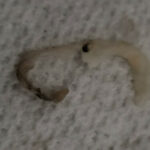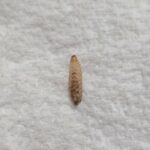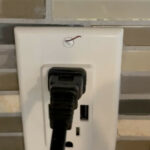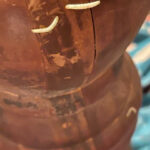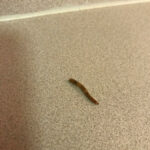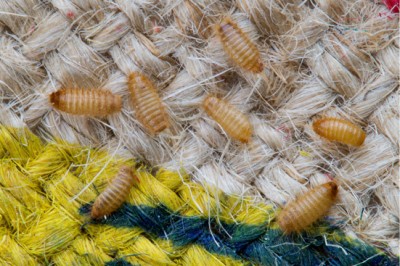
This guest article has been contributed by Jarrod Warkentin of www.spartanpestcontrol.com in Calgary, Alberta in Canada. Thank you, Jarrod!
Carpet Beetles & Carpet Beetle Larva
What are they?
Carpet beetles are a household pest found in Europe, North America, North Africa, and Asia. The adults cause little damage and can be ignored. They eat pollen and do not pose a threat aside from the eggs they lay. Unfortunately, their newly hatched eggs become larva that are very destructive and are often mistaken for a type of worm. The larva feed on fabric, carpets, and natural materials; they eat anything that contains keratin and can destroy clothing, blankets, and furniture. Carpet beetles have three life stages: egg, larva, and adult.
Adult carpet beetles enter the home through household plants, cracked windows, or open doors. They then lay eggs in dark, hidden areas such as in air ducts, closets, and underneath furniture. Each female lays between 25 and 100 eggs in the spring. These eggs hatch within two weeks.
The larva can take up to a year to fully develop into adults. As worms (larva), they will molt several times before they enter adulthood. During this time, they will consume large amounts of natural materials.
What Do They Look Like?
Carpet beetle eggs are white or cream and very small. They are about 1/64” long with spine-like projections at one end. Because of their size and colour, they are extremely difficult to see.
Carpet beetle larva are sometimes called “woolly bears” because of their fuzzy bodies. The worm-like larva are 0.15 to 0.20 inches long and look similar to caterpillars. Their bodies are covered in hairs with an alternating light and dark striped pattern. The stripes are usually light brown to white and dark brown to black. They also have three sets of hairs on the end of their abdomen that are used for self defense.
Adult carpet beetles are 0.007 to 0.14 inches long. They have a round, almost circular body. Their upper body is covered in scales. They have irregular white, brown and yellow patches on their bodies with white scales down the left and right sides. They contain three body segments and have straight antennae.
Signs of Infestation:
• Adult beetles on windowsills
• Irregular holes in fabrics, carpets, etc.
• Patches of missing cloth, leather, or fabric
• Skin casings from larva
• Hives, increased asthma, or allergy symptoms.
Carpet beetle larva cause large amounts of damage to natural fibres like carpets, furniture, and clothing. Their destruction can be distinguished from clothes moths by the size of the holes. Carpet beetle larva leave larger holes or patches of missing fabric around the folds. Sometimes, there are few holes but many threadbare or thin areas. Moth holes are generally small and found throughout the whole garment. Carpet beetle larva often reside in long term storage areas; check natural material items in these areas often for signs of damage.
Shed hairs from the worm like larva can also cause health problems. If touched, they can prick the skin, causing marks that look like bed bug bites. These hairs can also worsen eczema or asthma symptoms.
Non-chemical treatments
Treating carpet beetle larva with pesticides is often ineffective. Pesticides seldom reach into the folds of fabric. The best types of treatments involve detailed cleaning using heat and a vacuum cleaner.
• Vacuuming: Use the small hose attachment to vacuum around baseboards, on and under furniture, and in any nooks and crannies. Use the regular carpet vacuum attachment for the carpet or a hardwood attachment for the floor. Make sure to vacuum every inch of the space, particularly storage areas. After vacuuming, immediately place the vacuum contents in a garbage bag and seal.
• Steam Cleaning: Steam is an effective killer of many pests including carpet beetles. It can be used on floors and furniture. First vacuum the items to remove bugs, dirt etc., before steam cleaning.
• Air out Clothing and Bedding: Before and after storing, air out clothing and bedding on a warm, sunny day. The worms in particular avoid sunlight. ?
• Wash and Dry on High Heat: High heat in the washer and dryer will kill all stages of an infestation. Before and after storing clothing, wash and dry it on high heat. Sheets should be washed every two weeks, if not every week to prevent infestations.
• Glue traps: Glue traps will trap the adults, preventing them from reproducing. These traps work well with or without an attractant. Glue traps are most effective at early stages when there are few larvae. They should be placed near storage areas, basements, attics, and under furniture. These should be replaced regularly and kept away from pets and small children.
• Deep Freeze Infected Items: If you don’t want to use high heat, you can use cold. Place infested items in a sealed plastic bag. Make sure that they are dry before freezing. Next, place them in a stand-alone freezer. Temperatures at or below -20F will kill all insects.
Prevention:
• Regular Cleaning: Keep your home free of crumbs, debris, dust, and pet food. Attention should be given to low traffic areas and cracks and crevices. Make sure to vacuum and steam clean curtains, furniture, and area rugs.
• Store Food in Air-tight Containers: These containers prevent adult carpet beetles from finding food. They cannot chew through plastic or glass containers.
• Wash Clothing before Storage: Washing in hot water kills all stages of the carpet beetle. It also removes sweat which attracts the beetles.
• Store Fabric Items in Air-tight Containers. These containers will prevent carpet beetles from laying eggs or feeding on the items. For extra security, put the item in a plastic bag before placing it in an air-tight container.
• Check Plants for Bugs: Before bringing any flowers or plants into your home, check them for carpet beetles and larva. Also check any plants that are against your home.
• Fix holes in Screens/doors/vents: Any cracks or holes will allow beetles to enter your home. This is a particular concern when plants rest against or near the foundation and walls of your home.
• Remove spiderwebs, nests, dead bugs etc.: Carpet beetles nest in unused areas and bird or rodent nests. Eliminating this debris will remove living spaces.
Thank you again to Jarrod of www.spartanpestcontrol.com for contributing this article!
All About Worms is always free, always reader-supported. Your tips via CashApp, Venmo, or Paypal are appreciated! Receipts will come from ISIPP Publishing.
You might also find these guys interesting!






